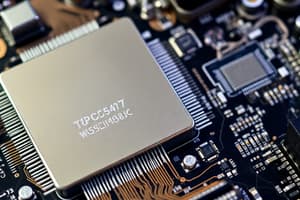Podcast
Questions and Answers
What is the main function of the Arithmetic Logic Unit (ALU) in a microprocessor?
What is the main function of the Arithmetic Logic Unit (ALU) in a microprocessor?
- Perform data storage operations
- Control the processor's overall operation
- Execute instructions from memory
- Perform arithmetic and logical operations (correct)
Which architecture allows simultaneous access to instructions and data by having separate memory spaces?
Which architecture allows simultaneous access to instructions and data by having separate memory spaces?
- CISC Architecture
- Microcontroller Architecture
- Von Neumann Architecture
- Harvard Architecture (correct)
What does the 'fetch-decode-execute' cycle in a microprocessor represent?
What does the 'fetch-decode-execute' cycle in a microprocessor represent?
- The process of cooling and managing power
- The design of microprocessors
- The method of data storage within the CPU
- The sequence of operations to execute instructions (correct)
Which of the following is true about RISC (Reduced Instruction Set Computing)?
Which of the following is true about RISC (Reduced Instruction Set Computing)?
How does clock speed affect the performance of a microprocessor?
How does clock speed affect the performance of a microprocessor?
What role do registers play in a microprocessor?
What role do registers play in a microprocessor?
Which microprocessor type is characterized by a complex instruction set, such as the Intel x86 architecture?
Which microprocessor type is characterized by a complex instruction set, such as the Intel x86 architecture?
What is a significant trend in microprocessor development concerning integration?
What is a significant trend in microprocessor development concerning integration?
Flashcards are hidden until you start studying
Study Notes
Definition
- A microprocessor is a compact integrated circuit that serves as the brain of a computer, executing instructions and processing data.
Key Components
- Arithmetic Logic Unit (ALU): Performs arithmetic and logical operations.
- Control Unit (CU): Directs the operation of the processor and coordinates the execution of instructions.
- Registers: Small, fast storage locations within the CPU that hold data temporarily.
- Cache Memory: A small amount of high-speed memory used to store frequently accessed data and instructions.
Functionality
- Executes instructions from programs using a fetch-decode-execute cycle.
- Fetch: Retrieve an instruction from memory.
- Decode: Interpret the instruction.
- Execute: Perform the operation specified by the instruction.
Types of Microprocessors
- CISC (Complex Instruction Set Computing):
- Contains a large set of instructions.
- Example: Intel x86 architecture.
- RISC (Reduced Instruction Set Computing):
- Utilizes a smaller set of simple instructions for higher performance.
- Example: ARM architecture.
Architecture
- Von Neumann Architecture:
- Single memory space for instructions and data.
- Harvard Architecture:
- Separate memory for instructions and data, allowing simultaneous access.
Performance Factors
- Clock Speed: Measured in GHz; determines how many cycles per second the processor can execute.
- Bit Width: Refers to the width of the data bus (e.g., 32-bit, 64-bit) which affects processing power and memory addressing.
- Core Count: Number of independent processing units within the CPU, affecting multitasking and performance.
Applications
- Used in personal computers, servers, embedded systems, smartphones, and various consumer electronics.
Development Trends
- Increasing integration (System on Chip - SoC) combining CPU, GPU, and other components on a single die.
- Focus on power efficiency and heat management in portable devices.
- Continued advancements in quantum and neuromorphic computing as potential future directions.
Definition
- A microprocessor is an integrated circuit that functions as a computer's brain, executing instructions and processing data.
Key Components
- Arithmetic Logic Unit (ALU): Executes arithmetic and logical operations essential for processing.
- Control Unit (CU): Manages the execution of instructions and orchestrates the processor's activities.
- Registers: High-speed storage locations within the CPU that temporarily hold data for quick access.
- Cache Memory: Fast memory that stores frequently accessed data and instructions to enhance performance.
Functionality
- Microprocessors operate through a fetch-decode-execute cycle:
- Fetch: Obtains an instruction from memory.
- Decode: Interprets the instruction to understand what needs to be done.
- Execute: Carries out the operation specified by the instruction.
Types of Microprocessors
- CISC (Complex Instruction Set Computing):
- Features a broad range of instructions, enhancing flexibility. Notable example includes Intel x86 architecture.
- RISC (Reduced Instruction Set Computing):
- Employs a streamlined set of simpler instructions for improved performance, with ARM architecture as a leading example.
Architecture
- Von Neumann Architecture: Utilizes a single memory structure for both instructions and data.
- Harvard Architecture: Separates memory for instructions and data, allowing simultaneous access for enhanced efficiency.
Performance Factors
- Clock Speed: Measured in GHz, indicating the number of cycles the processor can execute per second.
- Bit Width: Represents the data bus width (e.g., 32-bit or 64-bit), influencing processing capability and memory range.
- Core Count: Refers to the number of independent processing units within the CPU, impacting multitasking capabilities and overall performance.
Applications
- Microprocessors are integral to personal computers, servers, embedded systems, smartphones, and various consumer electronics.
Development Trends
- The trend towards increased integration leads to System on Chip (SoC) designs, combining CPU, GPU, and additional components on a single die.
- Emphasis on power efficiency and effective heat management is crucial for portable devices.
- Ongoing advancements aim to explore quantum and neuromorphic computing as potential future pathways.
Studying That Suits You
Use AI to generate personalized quizzes and flashcards to suit your learning preferences.




